check engine DODGE SPRINTER 2006 1.G User Guide
[x] Cancel search | Manufacturer: DODGE, Model Year: 2006, Model line: SPRINTER, Model: DODGE SPRINTER 2006 1.GPages: 330, PDF Size: 10.82 MB
Page 167 of 330
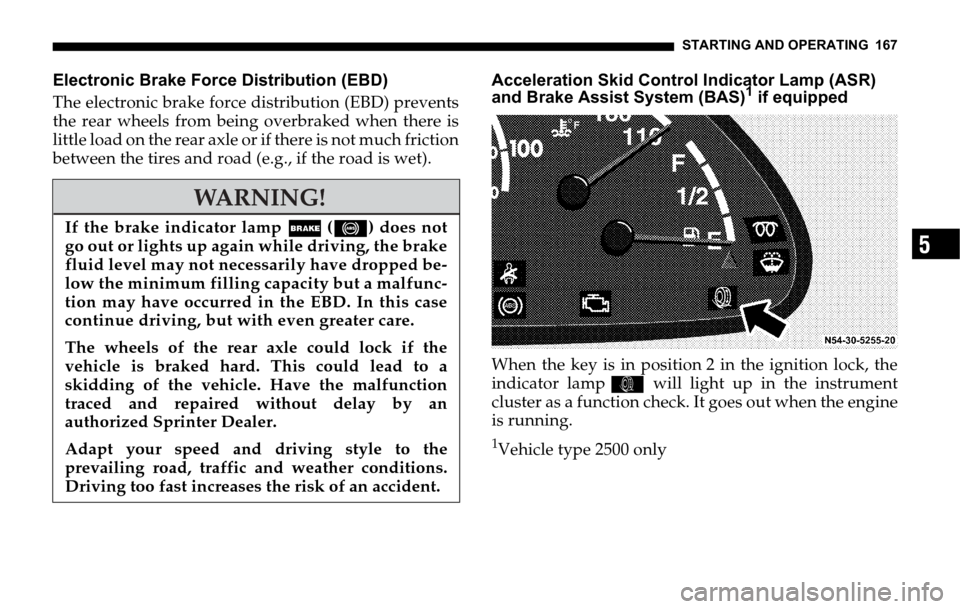
STARTING AND OPERATING 167
5
Electronic Brake Force Distribution (EBD)
The electronic brake force distribution (EBD) prevents
the rear wheels from being overbraked when there is
little load on the rear axle or if there is not much friction
between the tires and road (e.g., if the road is wet).Acceleration Skid Control Indicator Lamp (ASR)
and Brake Assist System (BAS)1 if equipped
When the key is in position 2 in the ignition lock, the
indicator lampk will light up in the instrument
cluster as a function check. It goes out when the engine
is running.
1Vehicle type 2500 only
WARNING!
If the brake indicator lamp ;(-) does not
go out or lights up again while driving, the brake
fluid level may not necessarily have dropped be-
low the minimum filling capacity but a malfunc-
tion may have occurred in the EBD. In this case
continue driving, but with even greater care.
The wheels of the rear axle could lock if the
vehicle is braked hard. This could lead to a
skidding of the vehicle. Have the malfunction
traced and repaired without delay by an
authorized Sprinter Dealer.
Adapt your speed and driving style to the
prevailing road, traffic and weather conditions.
Driving too fast increases the risk of an accident.
Page 173 of 330
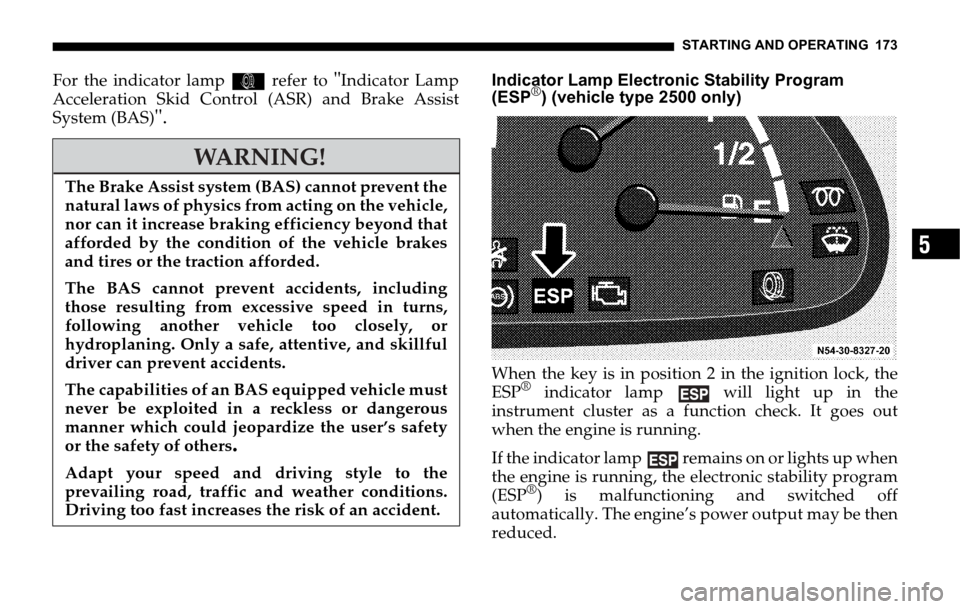
STARTING AND OPERATING 173
5
For the indicator lamp k refer to "Indicator Lamp
Acceleration Skid Control (ASR) and Brake Assist
System (BAS)
".
Indicator Lamp Electronic Stability Program
(ESP®) (vehicle type 2500 only)
When the key is in position 2 in the ignition lock, the
ESP
® indicator lamp will light up in the
instrument cluster as a function check. It goes out
when the engine is running.
If the indicator lamp remains on or lights up when
the engine is running, the electronic stability program
(ESP
®) is malfunctioning and switched off
automatically. The engine’s power output may be then
reduced.
WARNING!
The Brake Assist system (BAS) cannot prevent the
natural laws of physics from acting on the vehicle,
nor can it increase braking efficiency beyond that
afforded by the condition of the vehicle brakes
and tires or the traction afforded.
The BAS cannot prevent accidents, including
those resulting from excessive speed in turns,
following another vehicle too closely, or
hydroplaning. Only a safe, attentive, and skillful
driver can prevent accidents.
The capabilities of an BAS equipped vehicle must
never be exploited in a reckless or dangerous
manner which could jeopardize the user’s safety
or the safety of others
.
Adapt your speed and driving style to the
prevailing road, traffic and weather conditions.
Driving too fast increases the risk of an accident.
Page 210 of 330

210 STARTING AND OPERATING
If diesel fuels are used with a sulphur content
exceeding 0.5 % by weight, engine oil change intervals
must be shortened. Please contact your Sprinter Dealer
to obtain the necessary information.
Refueling from drums or canisters may lead to the fuel
becoming contaminated. This in turn can cause faults
in the fuel system. Always filter the fuel before adding
it to the vehicle’s tank.Fuel Filter with Water Separator
Check the water separator when the fuel indicator
lamp does not go out or comes on while the engine
is running.
The interval for changing the fuel filter is reduced to
10,000 miles (about 15,000 km).
WARNING!
Under no circumstances should gasoline be mixed
with diesel fuel.
Due to the high pressure and high temperature in
the injection system, there is a risk of fire and
explosion.
In addition, there is a risk of engine damage.
Always follow basic safety rules when working
with any combustible material.
Page 246 of 330
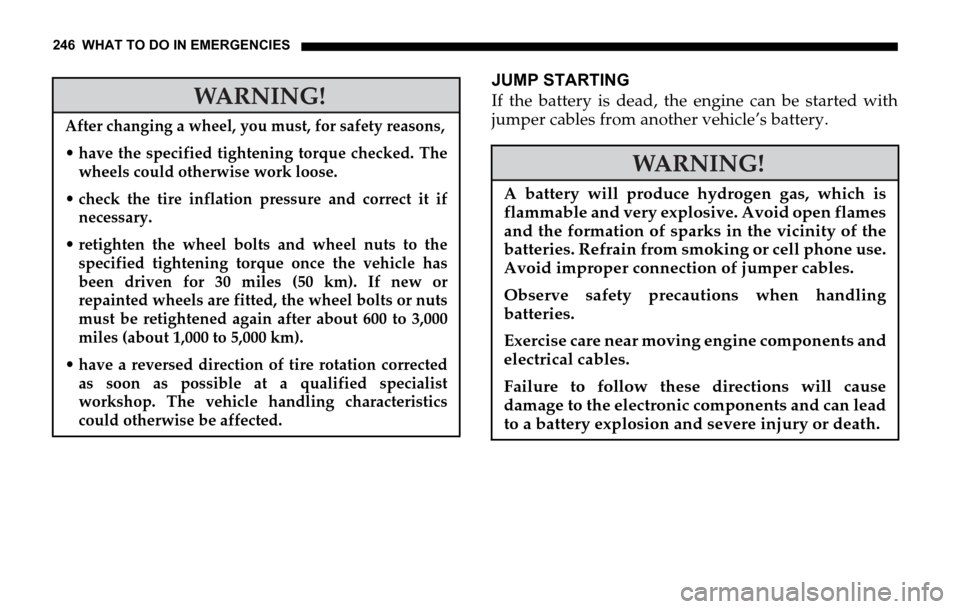
246 WHAT TO DO IN EMERGENCIES
JUMP STARTING
If the battery is dead, the engine can be started with
jumper cables from another vehicle’s battery.
WARNING!
After changing a wheel, you must, for safety reasons,
have the specified tightening torque checked. The
wheels could otherwise work loose.
check the tire inflation pressure and correct it if
necessary.
retighten the wheel bolts and wheel nuts to the
specified tightening torque once the vehicle has
been driven for 30 miles (50 km). If new or
repainted wheels are fitted, the wheel bolts or nuts
must be retightened again after about 600 to 3,000
miles (about 1,000 to 5,000 km).
have a reversed direction of tire rotation corrected
as soon as possible at a qualified specialist
workshop. The vehicle handling characteristics
could otherwise be affected.WARNING!
A battery will produce hydrogen gas, which is
flammable and very explosive. Avoid open flames
and the formation of sparks in the vicinity of the
batteries. Refrain from smoking or cell phone use.
Avoid improper connection of jumper cables.
Observe safety precautions when handling
batteries.
Exercise care near moving engine components and
electrical cables.
Failure to follow these directions will cause
damage to the electronic components and can lead
to a battery explosion and severe injury or death.
Page 251 of 330

MAINTAINING YOUR VEHICLE
7
CONTENTS
�Q Engine Compartment . . . . . . . . . . . . . . . . . . . . . . . 253
�Q Sprinter Original Parts . . . . . . . . . . . . . . . . . . . . . . 255
�Q Service Products . . . . . . . . . . . . . . . . . . . . . . . . . . . 255
�…Disposal of Service Products . . . . . . . . . . . . . . 256
�Q Emission Related Component Warranty
Statement . . . . . . . . . . . . . . . . . . . . . . . . . . . . . . . . 256
�Q Regular Checks . . . . . . . . . . . . . . . . . . . . . . . . . . . . 256
�…Windshield Washer System Fluid Reservoir . 257
�…Air Filter Restriction Indicator (Optional) . . . 258
�…Approved Engine Oils . . . . . . . . . . . . . . . . . . . . 258
�…Engine Oil Level . . . . . . . . . . . . . . . . . . . . . . . . 259
�…Ribbed V-Belt . . . . . . . . . . . . . . . . . . . . . . . . . . . 260
�…Hydraulic Brake System, Clutch
Mechanism Fluid Level . . . . . . . . . . . . . . . . . . . 261
�…Brake fluid . . . . . . . . . . . . . . . . . . . . . . . . . . . . . . 261
�…Engine Cooling System . . . . . . . . . . . . . . . . . . . 261
�…Engine Coolant . . . . . . . . . . . . . . . . . . . . . . . . . . 262
�…Checking Coolant Level . . . . . . . . . . . . . . . . . . 263
�Q Winter Operation . . . . . . . . . . . . . . . . . . . . . . . . . . 265
�Q Batteries . . . . . . . . . . . . . . . . . . . . . . . . . . . . . . . . . . 265
�…Disconnecting the Battery . . . . . . . . . . . . . . . . . 266
�…Reconnecting the Battery . . . . . . . . . . . . . . . . . . 266
�…Charging the Battery . . . . . . . . . . . . . . . . . . . . . 267
�Q Replacing Wiper Blades . . . . . . . . . . . . . . . . . . . . . 268
�…Appearance Care and Corrosion Protection . 269
�…Power Washer . . . . . . . . . . . . . . . . . . . . . . . . . . . 271
�…Automatic Car Wash . . . . . . . . . . . . . . . . . . . . . 271
�…Tar Stains . . . . . . . . . . . . . . . . . . . . . . . . . . . . . . . 272
�…Paintwork, Painted Body Components . . . . . . 272
�…Engine Cleaning . . . . . . . . . . . . . . . . . . . . . . . . . 272
�…Vehicle Washing . . . . . . . . . . . . . . . . . . . . . . . . . 272
�…Ornamental Moldings . . . . . . . . . . . . . . . . . . . . 273
Page 256 of 330

256 MAINTAINING YOUR VEHICLE
Disposal of Service Products
Dispose of service products and of parts which come
into contact with them (e.g. filters) in an
environmentally responsible manner. Comply with
applicable bars and regulations.
EMISSION RELATED COMPONENT WARRANTY
STATEMENT
The Manufacturer warrants to the original and each
subsequent owner of a Sprinter heavy-duty on
highway diesel engine that:
(1) the engine was designed, built and equipped so as
to conform at the time of sale with the applicable
regulations adopted by the Federal Environmental
Protection Agency, and
(2) the emission control system of such engine is free
from defects in materials and workmanship which
would cause it not to conform with those regulations
for a period of use of five years or 100 000 miles or
3 000 hours of engine operation, whichever occurs
first.REGULAR CHECKS
WARNING!
When the hood is open, there is a risk of injury
due to very hot engine components.
When the engine is running or the key is in posi-
tion 2 in the ignition lock, there is a risk of injury
due to moving engine components and the electri-
cal system.
If you see flames or smoke coming from the
engine compartment, or if the coolant temperature
gauge indicates that the engine is overheated, do
not open the hood. Move away from vehicle and
do not open the hood until the engine has cooled.
If necessary, call the fire department.
Page 257 of 330
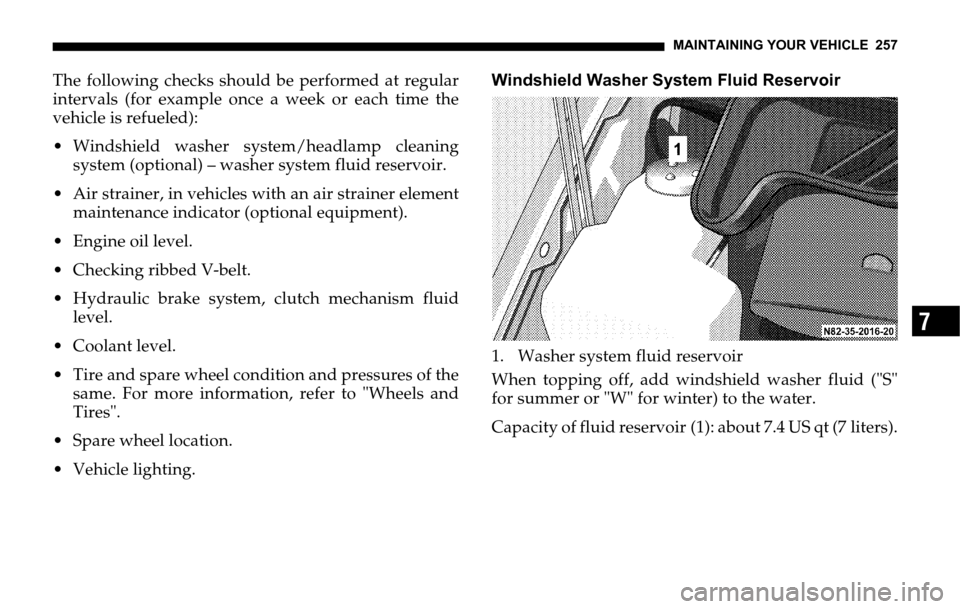
MAINTAINING YOUR VEHICLE 257
7
The following checks should be performed at regular
intervals (for example once a week or each time the
vehicle is refueled):
Windshield washer system/headlamp cleaning
system (optional) – washer system fluid reservoir.
Air strainer, in vehicles with an air strainer element
maintenance indicator (optional equipment).
Engine oil level.
Checking ribbed V-belt.
Hydraulic brake system, clutch mechanism fluid
level.
Coolant level.
Tire and spare wheel condition and pressures of the
same. For more information, refer to "Wheels and
Tires".
Spare wheel location.
Vehicle lighting.Windshield Washer System Fluid Reservoir
1. Washer system fluid reservoir
When topping off, add windshield washer fluid ("S"
for summer or "W" for winter) to the water.
Capacity of fluid reservoir (1): about 7.4 US qt (7 liters).
Page 260 of 330
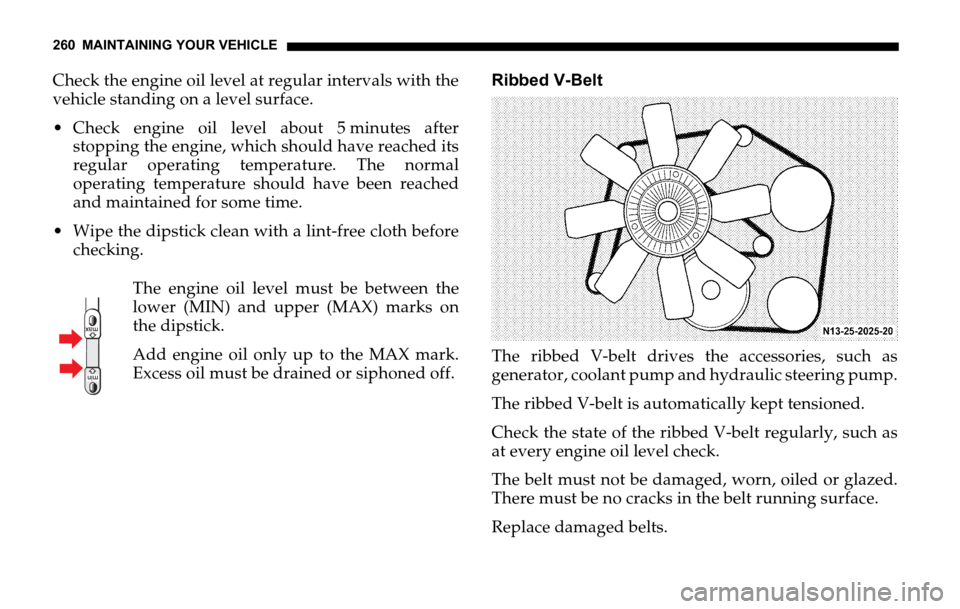
260 MAINTAINING YOUR VEHICLE
Check the engine oil level at regular intervals with the
vehicle standing on a level surface.
Check engine oil level about 5 minutes after
stopping the engine, which should have reached its
regular operating temperature. The normal
operating temperature should have been reached
and maintained for some time.
Wipe the dipstick clean with a lint-free cloth before
checking.
The engine oil level must be between the
lower (MIN) and upper (MAX) marks on
the dipstick.
Add engine oil only up to the MAX mark.
Excess oil must be drained or siphoned off.Ribbed V-Belt
The ribbed V-belt drives the accessories, such as
generator, coolant pump and hydraulic steering pump.
The ribbed V-belt is automatically kept tensioned.
Check the state of the ribbed V-belt regularly, such as
at every engine oil level check.
The belt must not be damaged, worn, oiled or glazed.
There must be no cracks in the belt running surface.
Replace damaged belts.
Page 261 of 330
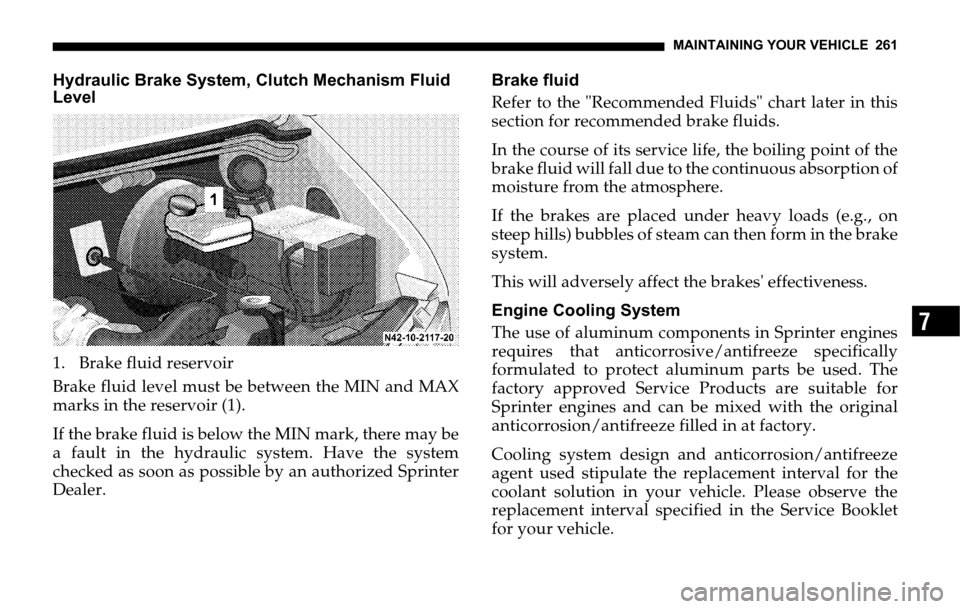
MAINTAINING YOUR VEHICLE 261
7
Hydraulic Brake System, Clutch Mechanism Fluid
Level
1. Brake fluid reservoir
Brake fluid level must be between the MIN and MAX
marks in the reservoir (1).
If the brake fluid is below the MIN mark, there may be
a fault in the hydraulic system. Have the system
checked as soon as possible by an authorized Sprinter
Dealer.Brake fluid
Refer to the "Recommended Fluids" chart later in this
section for recommended brake fluids.
In the course of its service life, the boiling point of the
brake fluid will fall due to the continuous absorption of
moisture from the atmosphere.
If the brakes are placed under heavy loads (e.g., on
steep hills) bubbles of steam can then form in the brake
system.
This will adversely affect the brakes' effectiveness.
Engine Cooling System
The use of aluminum components in Sprinter engines
requires that anticorrosive/antifreeze specifically
formulated to protect aluminum parts be used. The
factory approved Service Products are suitable for
Sprinter engines and can be mixed with the original
anticorrosion/antifreeze filled in at factory.
Cooling system design and anticorrosion/antifreeze
agent used stipulate the replacement interval for the
coolant solution in your vehicle. Please observe the
replacement interval specified in the Service Booklet
for your vehicle.
Page 262 of 330

262 MAINTAINING YOUR VEHICLE
Failure to use MB 325.0 anticorrosion/antifreeze and/or
equivalent to DaimlerChrysler material standard MS-
9769 and/or adhere to the specified replacement interval
may result in a significantly shortened service life.
For coolant composition and water quality, contact
your authorized Sprinter Dealer.
Engine Coolant
The coolant is a mixture of water and a corrosion
inhibitor/antifreeze additive. Within the cooling
system, the corrosion inhibitor/antifreeze ensures
anti-corrosion protection
antifreeze protection
a higher boiling point.
The coolant added in the factory ensures adequate
antifreeze and anti-corrosion protection.
Refer to the "Recommended Fluids" chart for coolant
recommendations.
For reasons of anti-corrosion protection and to increase
the boiling point, the coolant added to the cooling
system is designed for all year round operation – even
in countries with high prevailing temperatures.Have the coolant renewed at least every 15 years or
after 160,000 miles.
When the coolant is renewed, the new coolant should
contain 50% antifreeze/corrosion inhibitor by volume.
This corresponds to antifreeze protection down to -
37 °C/-35°F.
Do not exceed a proportion of about 55 % by volume
(antifreeze protection down to about -45 °C/-49 °F) as
the heat dissipation properties then deteriorate.
In the event of coolant loss, do not add water only, but
sufficient antifreeze/corrosion inhibitor to maintain
the correct concentration.
The water in the coolant must satisfy certain
requirements. These are often met by tap supply
drinking water.
The water must be specially prepared if the water
quality does not come up to the required standards.
Have the corrosion inhibitor/antifreeze concentration
in the coolant checked at the outset of winter,
respectively once a year in countries with high
prevailing temperatures.